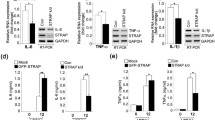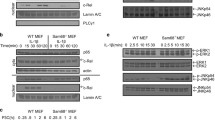Abstract
Recent data have shown that nucleotide-binding domain leucine-rich repeat proteins (NLRs), a class of innate immune receptors that respond to pathogen attack or cellular stress, have gained increasing attention. NLRC5 (NLR family, CARD domain containing 5) is the largest member of the NLR family, which has recently been identified as a critical regulator of immune responses. Until recently, the function of NLRC5 has been a matter of debate. In this study, we explore the role of NLRC5 in cytokine secretion and the role of the nuclear factor-κB (NF-κB) signaling pathway in tumor necrosis factor-alpha (TNF-α)-induced NLRC5 expression in LX-2 cells. We demonstrated that overexpression of NLRC5 results in an upregulation of IL-6 and IL-1β secretion. On the other hand, knockdown of NLRC5 by transfecting siRNA decreased IL-6 and IL-1β secretion in LX-2 cells. Meanwhile, the results showed that pyrrolidine dithiocarbamate (PDTC) (a specific inhibitor of the NF-κB signaling pathway) inhibited NLRC5 expression and NLRC5 silencing could increase the expression levels of p65 in cell nucleus accompanied with upregulated phosphorylation of Smad3 protein levels in response to TNF-α. These results indicated that NLRC5 plays a significant role in TNF-α-enhanced cytokine (IL-6 and IL-1β) secretion of LX-2 cells and the NF-κB/Smad3 signal pathway is involved in its induction of expression.









Similar content being viewed by others
References
Veidal, S.S., M.A. Karsdal, A. Nawrocki, M.R. Larsen, Y. Dai, Q. Zheng, et al. 2011. Assessment of proteolytic degradation of the basement membrane: A fragment of type IV collagen as a biochemical marker for liver fibrosis. Fibrogenesis & Tissue Repair 4: 22.
Wallace, K., A.D. Burt, and M.C. Wright. 2008. Liver fibrosis. The Biochemical Journal 411: 1–18.
Wells, R.G. 2005. The role of matrix stiffness in hepatic stellate cell activation and liver fibrosis. Journal of Clinical Gastroenterology 39(S1): 58–61.
Safadi, R., and S.L. Friedman. 2002. Hepatic fibrosis—Role of hepatic stellate cell activation. MedGenMed 4: 27.
Kim, Y., M.I. Fiel, E. Albanis, H.I. Chou, W. Zhang, G. Khitrov, et al. 2012. Anti-fibrotic activity and enhanced interleukin-6 production by hepatic stellate cells in response to imatinib mesylate. Liver Int Off J Int Assoc Study Liver 32: 1008–1017.
Inohara, C., C. McDonald, and G. Nunez. 2005. NOD-LRR proteins: Role in host-microbial interactions and inflammatory disease. Annual Review of Biochemistry 74: 355–383.
Abrahams, V.M. 2011. The role of the Nod-like receptor family in trophoblast innate immune responses. Journal of Reproductive Immunology 88: 112–117.
Martin, A.P., T. Marinkovic, C. Canasto-Chibuque, R. Latif, J.C. Unkeless, T.F. Davies, et al. 2009. CCR7 deficiency in NOD mice leads to thyroiditis and primary hypothyroidism. Journal of Immunology 183: 3073–3080.
Schroder, K., and J. Tschopp. 2010. The inflammasomes. Cell 140: 821–832.
Benko, S., D.J. Philpott, and S.E. Girardin. 2008. The microbial and danger signals that activate Nod-like receptors. Cytokine 43: 368–373.
Lian, L., C. Ciraci, G. Chang, J. Hu, and S.J. Lamont. 2012. NLRC5 knockdown in chicken macrophages alters response to LPS and poly (I:C) stimulation. BMC Veterinary Research 8: 23.
Yao, Y., and Y. Qian. 2013. Expression regulation and function of NLRC5. Protein & Cell 4: 168–175.
Li, L., Xu, T., Huang, C., Peng, Y., Li, J., 2014. NLRC5 Mediates cytokine secretion in RAW264.7 macrophages and modulated by the JAK2/STAT3 pathway. Inflammation.
Xu, L., A.Y. Hui, E. Albanis, M.J. Arthur, S.M. O’Byrne, W.S. Blaner, et al. 2005. Human hepatic stellate cell lines, LX-1 and LX-2: New tools for analysis of hepatic fibrosis. Gut 54: 142–151.
Xia, Y., J. Chen, Y. Cao, C. Xu, R. Li, Y. Pan, et al. 2013. Wedelolactone exhibits anti-fibrotic effects on human hepatic stellate cell line LX-2. European Journal of Pharmacology 714: 105–111.
Sun, B., and M. Karin. 2008. NF-kappaB signaling, liver disease and hepatoprotective agents. Oncogene 27: 6228–6244.
Mormone, E., J. George, and N. Nieto. 2011. Molecular pathogenesis of hepatic fibrosis and current therapeutic approaches. Chemico-Biological Interactions 193: 225–231.
Zhang, Y., and X. Yao. 2011. Suppressive effects of YiGanKang, a combination of Chinese herbs, on collagen synthesis in hepatic stellate cell. Journal of Ethnopharmacology 134: 949–952.
Kisseleva, T., and D.A. Brenner. 2011. Anti-fibrogenic strategies and the regression of fibrosis. Best Practice & Research Clinical Gastroenterology 25: 305–317.
Allen, I.C. 2011. A NOD to zebrafish models of inflammatory bowel disease pathogenesis. Disease Models & Mechanisms 4: 711–712.
Koppula, S., W.J. Kim, J. Jiang, D.W. Shim, N.H. Oh, T.J. Kim, et al. 2013. Carpesium macrocephalum attenuates lipopolysaccharide-induced inflammation in macrophages by regulating the NF-kappa B/I kappa B-alpha, Akt, and STAT signaling pathways. American Journal of Chinese Medicine 41: 927–943.
Fan, G.W., Zhang, Y., Jiang, X., Zhu, Y., Wang, B., Su, L., et al. 2013. Anti-inflammatory activity of Baicalein in LPS-Stimulated RAW264.7 macrophages via estrogen receptor and NF-kappaB-dependent pathways. Inflammation.
Lee, T.F., Y.L. Lin, and Y.T. Huang. 2011. Kaerophyllin inhibits hepatic stellate cell activation by apoptotic bodies from hepatocytes. Liver Int Off J Int Assoc Study Liver 31: 618–629.
Acknowledgments
This work was supported by grants from the key program of the National Natural Science Foundation of China No. 81273526 and 81473268.
Conflict of Interest
We declare that we have no conflict of interest.
Author information
Authors and Affiliations
Corresponding author
Rights and permissions
About this article
Cite this article
Xu, T., Ni, Mm., Huang, C. et al. NLRC5 Mediates IL-6 and IL-1β Secretion in LX-2 Cells and Modulated by the NF-κB/Smad3 Pathway. Inflammation 38, 1794–1804 (2015). https://doi.org/10.1007/s10753-015-0157-6
Published:
Issue Date:
DOI: https://doi.org/10.1007/s10753-015-0157-6




